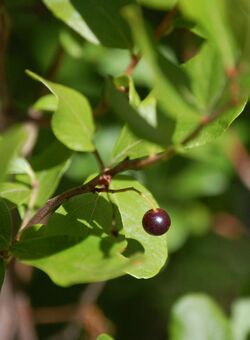Biology:Gaylussacia baccata
| Black huckleberry | |
|---|---|

| |
| Scientific classification | |
| Kingdom: | Plantae |
| Clade: | Tracheophytes |
| Clade: | Angiosperms |
| Clade: | Eudicots |
| Clade: | Asterids |
| Order: | Ericales |
| Family: | Ericaceae |
| Genus: | Gaylussacia |
| Species: | G. baccata
|
| Binomial name | |
| Gaylussacia baccata (Wangenh.) K. Koch 1872
| |
| Synonyms[1] | |
|
List
| |
Gaylussacia baccata, the black huckleberry, is a common huckleberry found throughout a wide area of eastern North America.
Distribution
The plant is native to Eastern Canada and the Great Lakes region, the Midwestern and Northeastern United States, and the Appalachian Mountains, the Ohio/Mississippi/Tennessee Valley, and Southeastern United States. The range extends from Newfoundland west to Manitoba and Minnesota, south as far as Arkansas, Alabama, and Georgia.[2]
Description
Gaylussacia baccata closely resembles the native blueberry plants (Vaccinium species) with which it grows in the same habitats. However, it can be readily identified by the numerous resin dots on the undersides of the leaves which glitter when held up to the light. Gaylussacia baccata is a shrub up to 150 cm (5 feet) tall, forming extensive colonies. Flowers are in dangling groups of 3–7, orange or red, bell-shaped. Berries are dark blue, almost black, rarely white.[3]
Berries are sweet and tasty. People and animals eat them raw, jellied, or baked into pancakes, muffins, and many other items.[4]:39
Ecology
The shrub is considered fire-resistant due to surviving rhizomes quickly sending out new shoots following fires.[5]
It is a larval host to the brown elfin, Gordian sphinx, Henry's elfin, and huckleberry sphinx.[6]
See also
- Vaccinium membranaceum — with "black huckleberry" as common name also.
References
- ↑ "Gaylussacia baccata". World Checklist of Selected Plant Families (WCSP). Royal Botanic Gardens (Kew). http://www.theplantlist.org/tpl1.1/record/kew-2818325.
- ↑ "Gaylussacia baccata", State-level distribution map from the North American Plant Atlas (NAPA) (Biota of North America Program (BONAP)), 2014, http://bonap.net/MapGallery/State/Gaylussacia%20baccata.png
- ↑ Sorrie, Bruce A.; Weakley, Alan S.; Tucker, Gordon C. (2009), "Gaylussacia baccata", in Flora of North America Editorial Committee, Flora of North America North of Mexico (FNA), 8, New York and Oxford, http://www.efloras.org/florataxon.aspx?flora_id=1&taxon_id=242416580
- ↑ Gibbons, Euell (1962). Stalking the Wild Asparagus. New York: David McKay. pp. xiii+303. ISBN 978-0-911469-03-5. OCLC 16227916.
- ↑ Matlack, Glenn R. (1997). "Resource Allocation among Clonal Shoots of the Fire-Tolerant Shrub Gaylussacia baccata". Oikos 80 (3): 509–518. doi:10.2307/3546624. ISSN 0030-1299. https://www.jstor.org/stable/3546624.
- ↑ The Xerces Society (2016), Gardening for Butterflies: How You Can Attract and Protect Beautiful, Beneficial Insects, Timber Press.
External links
Wikidata ☰ Q5528871 entry
 |

